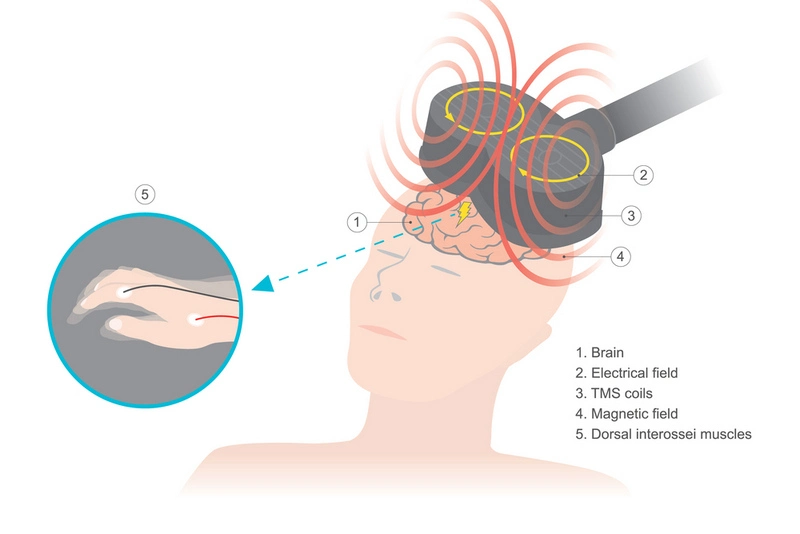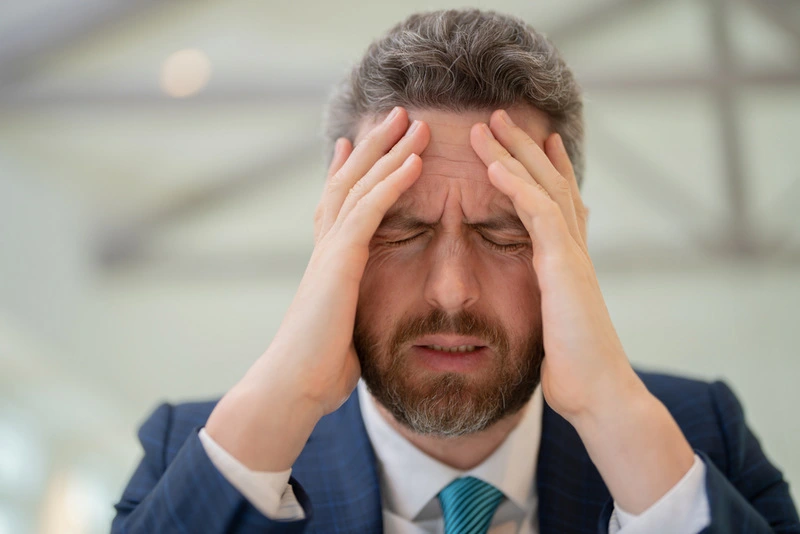This article will take a look into transcranial magnetic stimulation (TMS) as a form of treatment for migraines, exploring the use of TMS in alleviating symptoms of acute migraines.
Introduction
Migraines can be debilitating, coming on without much warning and taking away from your ability to focus, be in a bright room, be near noise, or otherwise function. For those with migraines, traditional medication for less severe headaches may prove ineffective, but today, Transcranial Magnetic Stimulation (TMS) is a breakthrough treatment approach for migraines. This article will explore the effectiveness of TMS in alleviating migraine symptoms and offer valuable information on this innovative therapy.
TMS
TMS is a form of non-invasive, non-pharmacological therapy for several conditions including:
During a session, you are placed in a comfortable chair, after which a professional places electrodes around your head and sends magnetic pulses into your brain. The design of TMS is such that it can penetrate significantly deeper than topical products or treatments, and it does not require any cutting or needles to be effective.
The procedures are so safe, in fact, that there are next to no side effects, and you do not need anesthesia. This means sessions, often lasting around 20 minutes, are things you can go to without needing to arrange a ride or take time off work for recovery.

The effects are often felt within the first few sessions and can last for several months. In the case of migraines, acute treatment can be highly effective because it starts almost immediately, and the short-term nature of the lasting impact is often enough to counter temporary or acute triggers such as changes in weather, pollutants in the environment, or stress.
Migraines
Migraines are triggered by different things in different people. Sometimes, eating things like aged cheese can cause a migraine. For others, it might be exposure to strong perfume or even hormonal changes.
Migraines are caused by abnormal activity in your brain, which can be triggered by several things, such as:
- Stress
- Flickering lights
- Changes in weather
- Exposure to light, smell, or other environmental conditions
- Hormonal changes
- Sleep pattern issues
- Food or drink
Whatever the triggers, they set off chain reactions of abnormal activity in the nerves and the chemicals within your brain. These changes can affect blood flow to the brain.
Migraines are significantly worse than regular headaches because they come often without warning. People might get about 10 minutes of things like blurred vision or other symptoms before the full migraine worsens to its apex. Migraines can last anywhere from a few hours to several days, leaving people feeling exhausted, foggy, and similar to a hangover.
- Over-the-counter options typically include things like migraine pills with caffeine, although caffeine can be taken by itself.
- Prescriptions can include Imitrex and Maxalt, both of which are triptans.
- Over-the-counter medications like anti-nausea medications can help with the nausea side of migraines, while common pain medications such as ibuprofen are also useful for moderate pain.

In some cases, understanding the triggers for your personal migraines goes a long way toward finding the right combination of treatments. Many times, doctors will ask that you keep a journal where you write down the things you were doing or eating at the time a migraine began. This can help narrow down triggers and make it easier to avoid or find other medication to help.
Understanding TMS for Migraine Relief
However, in other cases, medications, over-the-counter or otherwise, do not work to provide relief. Sometimes, people don’t want a prescription but rather something they can do to help manage the interference that migraines have without letting them get worse. That is where TMS can help.
What Is TMS for Migraines?
TMS migraine treatment is a safe and effective way to mitigate acute symptoms of a migraine when they manifest.
As most people have migraines that run in the family, it can be something that is proven useful for all affected members, too, with short, simple sessions available whenever symptoms begin.
How Does TMS Work for Migraines?
TMS for migraines works by mapping the brain and finding the areas where the abnormal brain activity is most likely taking place. Subsequent sessions can be used to send pulses to those areas in order to change their activity back to normal so as to reduce the causes and symptoms of a migraine.
The Effectiveness of TMS for Migraine Relief
For more than two decades, research has reviewed the link between TMS and migraine relief, studying both the potential for acute/chronic relief and any safety risks.
Research has confirmed for over twenty years that there is a low risk associated with TMS for migraines. Acute migraine treatment with TMS has been confirmed to be a safe, non-pharmacological treatment approach.
Clinical Insights and Research Findings
Several literature reviews evaluated the effectiveness of non-invasive TMS for migraine headaches. These controlled trials across five studies noted that the use of single-pulse TMS for migraine headaches was effective after a single attack.

These findings did note that the efficacy of TMS migraine treatment for chronic migraines was not nearly as significant as it was when used for individual, acute outbreaks of migraines.
Other studies found that low and high TMS migraine treatments saw a reported decrease of pain by 75% in patients after a single treatment, with participants reporting no more headaches of any kind 24 hours after their TMS.
Is TMS for Migraines Right for You?
So, how do you know if TMS for migraines is the right option for you? It comes down to the type of migraine with which you struggle most often.
If you struggle with periodic, acute migraine attacks triggered by things like stress, genetics, environment, pollutants, and the like, TMS for migraines could prove very useful as something to which you turn for acute relief.
By comparison, if you struggle with chronic migraines, TMS may not be the most effective treatment, particularly if you are looking to replace things like medication.
TMS for Migraine: A Glimpse into the Future
While at present, the majority of research regarding TMS for migraines has focused on potential side effects, whether low or high doses were necessary, and the effectiveness in chronic versus acute treatment, more research remains open for conclusions surrounding versions of TMS for migraine headaches that can provide long term solutions for chronic issues and also offer a potential combination of aid from both pharmacological options and non-pharmacological TMS.
Summing Up
Overall, TMS migraine treatment represents a promising breakthrough in the treatment of migraine. If you struggle with migraines, particularly acute migraines that can be triggered without warning, consult a physician to see if TMS for migraine headaches might work well for you in addition to other treatments or as an alternative to other treatments.